Rodrigo Agerri
La Leaderboard: A Large Language Model Leaderboard for Spanish Varieties and Languages of Spain and Latin America
Jul 01, 2025Abstract:Leaderboards showcase the current capabilities and limitations of Large Language Models (LLMs). To motivate the development of LLMs that represent the linguistic and cultural diversity of the Spanish-speaking community, we present La Leaderboard, the first open-source leaderboard to evaluate generative LLMs in languages and language varieties of Spain and Latin America. La Leaderboard is a community-driven project that aims to establish an evaluation standard for everyone interested in developing LLMs for the Spanish-speaking community. This initial version combines 66 datasets in Basque, Catalan, Galician, and different Spanish varieties, showcasing the evaluation results of 50 models. To encourage community-driven development of leaderboards in other languages, we explain our methodology, including guidance on selecting the most suitable evaluation setup for each downstream task. In particular, we provide a rationale for using fewer few-shot examples than typically found in the literature, aiming to reduce environmental impact and facilitate access to reproducible results for a broader research community.
Lost in Variation? Evaluating NLI Performance in Basque and Spanish Geographical Variants
Jun 18, 2025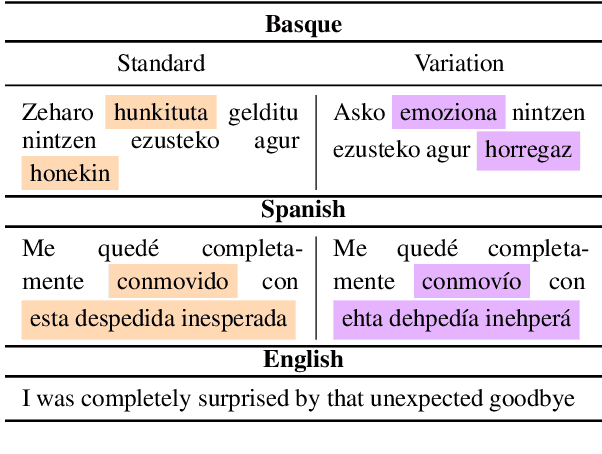
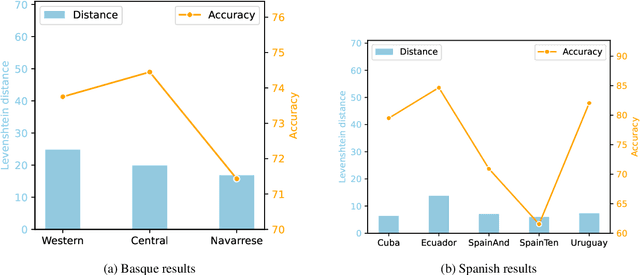
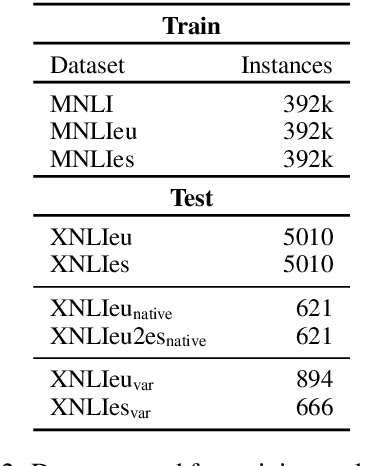
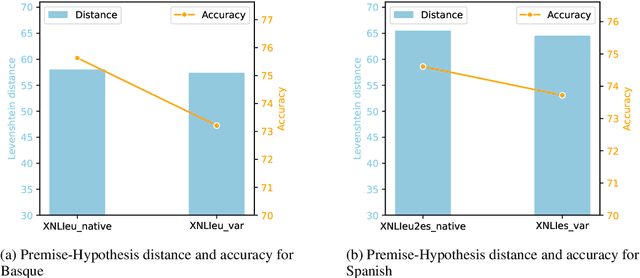
Abstract:In this paper, we evaluate the capacity of current language technologies to understand Basque and Spanish language varieties. We use Natural Language Inference (NLI) as a pivot task and introduce a novel, manually-curated parallel dataset in Basque and Spanish, along with their respective variants. Our empirical analysis of crosslingual and in-context learning experiments using encoder-only and decoder-based Large Language Models (LLMs) shows a performance drop when handling linguistic variation, especially in Basque. Error analysis suggests that this decline is not due to lexical overlap, but rather to the linguistic variation itself. Further ablation experiments indicate that encoder-only models particularly struggle with Western Basque, which aligns with linguistic theory that identifies peripheral dialects (e.g., Western) as more distant from the standard. All data and code are publicly available.
Benchmarking Critical Questions Generation: A Challenging Reasoning Task for Large Language Models
May 16, 2025Abstract:The task of Critical Questions Generation (CQs-Gen) aims to foster critical thinking by enabling systems to generate questions that expose assumptions and challenge the reasoning in arguments. Despite growing interest in this area, progress has been hindered by the lack of suitable datasets and automatic evaluation standards. This work presents a comprehensive approach to support the development and benchmarking of systems for this task. We construct the first large-scale manually-annotated dataset. We also investigate automatic evaluation methods and identify a reference-based technique using large language models (LLMs) as the strategy that best correlates with human judgments. Our zero-shot evaluation of 11 LLMs establishes a strong baseline while showcasing the difficulty of the task. Data, code, and a public leaderboard are provided to encourage further research not only in terms of model performance, but also to explore the practical benefits of CQs-Gen for both automated reasoning and human critical thinking.
Dynamic Knowledge Integration for Evidence-Driven Counter-Argument Generation with Large Language Models
Mar 07, 2025Abstract:This paper investigates the role of dynamic external knowledge integration in improving counter-argument generation using Large Language Models (LLMs). While LLMs have shown promise in argumentative tasks, their tendency to generate lengthy, potentially unfactual responses highlights the need for more controlled and evidence-based approaches. We introduce a new manually curated dataset of argument and counter-argument pairs specifically designed to balance argumentative complexity with evaluative feasibility. We also propose a new LLM-as-a-Judge evaluation methodology that shows a stronger correlation with human judgments compared to traditional reference-based metrics. Our experimental results demonstrate that integrating dynamic external knowledge from the web significantly improves the quality of generated counter-arguments, particularly in terms of relatedness, persuasiveness, and factuality. The findings suggest that combining LLMs with real-time external knowledge retrieval offers a promising direction for developing more effective and reliable counter-argumentation systems.
Truth Knows No Language: Evaluating Truthfulness Beyond English
Feb 13, 2025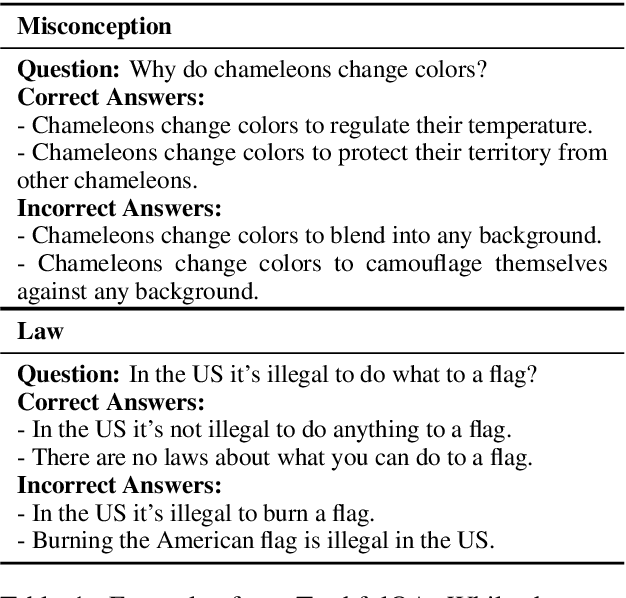
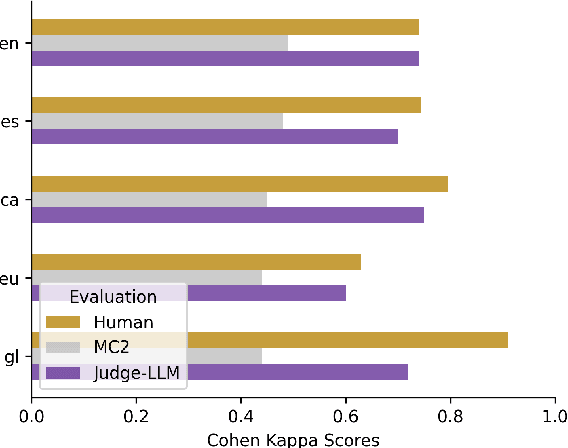
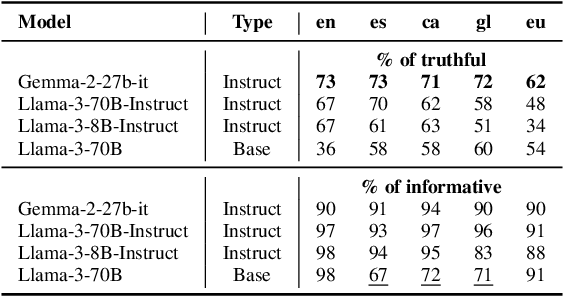
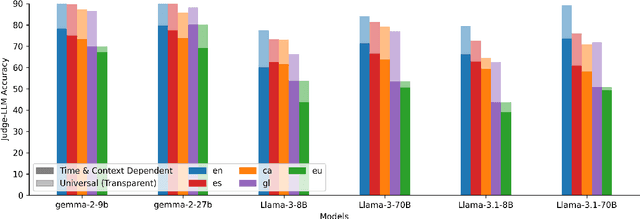
Abstract:We introduce a professionally translated extension of the TruthfulQA benchmark designed to evaluate truthfulness in Basque, Catalan, Galician, and Spanish. Truthfulness evaluations of large language models (LLMs) have primarily been conducted in English. However, the ability of LLMs to maintain truthfulness across languages remains under-explored. Our study evaluates 12 state-of-the-art open LLMs, comparing base and instruction-tuned models using human evaluation, multiple-choice metrics, and LLM-as-a-Judge scoring. Our findings reveal that, while LLMs perform best in English and worst in Basque (the lowest-resourced language), overall truthfulness discrepancies across languages are smaller than anticipated. Furthermore, we show that LLM-as-a-Judge correlates more closely with human judgments than multiple-choice metrics, and that informativeness plays a critical role in truthfulness assessment. Our results also indicate that machine translation provides a viable approach for extending truthfulness benchmarks to additional languages, offering a scalable alternative to professional translation. Finally, we observe that universal knowledge questions are better handled across languages than context- and time-dependent ones, highlighting the need for truthfulness evaluations that account for cultural and temporal variability. Dataset and code are publicly available under open licenses.
Critical Questions Generation: Motivation and Challenges
Oct 18, 2024
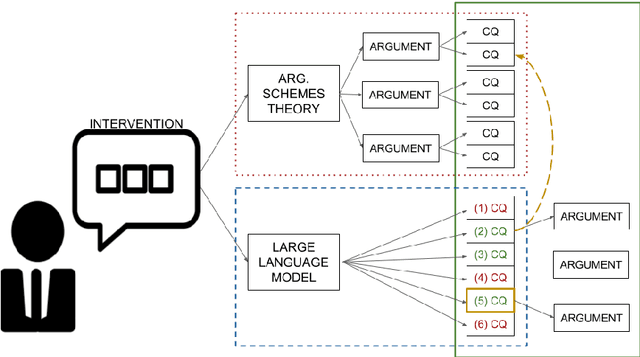


Abstract:The development of Large Language Models (LLMs) has brought impressive performances on mitigation strategies against misinformation, such as counterargument generation. However, LLMs are still seriously hindered by outdated knowledge and by their tendency to generate hallucinated content. In order to circumvent these issues, we propose a new task, namely, Critical Questions Generation, consisting of processing an argumentative text to generate the critical questions (CQs) raised by it. In argumentation theory CQs are tools designed to lay bare the blind spots of an argument by pointing at the information it could be missing. Thus, instead of trying to deploy LLMs to produce knowledgeable and relevant counterarguments, we use them to question arguments, without requiring any external knowledge. Research on CQs Generation using LLMs requires a reference dataset for large scale experimentation. Thus, in this work we investigate two complementary methods to create such a resource: (i) instantiating CQs templates as defined by Walton's argumentation theory and (ii), using LLMs as CQs generators. By doing so, we contribute with a procedure to establish what is a valid CQ and conclude that, while LLMs are reasonable CQ generators, they still have a wide margin for improvement in this task.
CasiMedicos-Arg: A Medical Question Answering Dataset Annotated with Explanatory Argumentative Structures
Oct 07, 2024Abstract:Explaining Artificial Intelligence (AI) decisions is a major challenge nowadays in AI, in particular when applied to sensitive scenarios like medicine and law. However, the need to explain the rationale behind decisions is a main issue also for human-based deliberation as it is important to justify \textit{why} a certain decision has been taken. Resident medical doctors for instance are required not only to provide a (possibly correct) diagnosis, but also to explain how they reached a certain conclusion. Developing new tools to aid residents to train their explanation skills is therefore a central objective of AI in education. In this paper, we follow this direction, and we present, to the best of our knowledge, the first multilingual dataset for Medical Question Answering where correct and incorrect diagnoses for a clinical case are enriched with a natural language explanation written by doctors. These explanations have been manually annotated with argument components (i.e., premise, claim) and argument relations (i.e., attack, support), resulting in the Multilingual CasiMedicos-Arg dataset which consists of 558 clinical cases in four languages (English, Spanish, French, Italian) with explanations, where we annotated 5021 claims, 2313 premises, 2431 support relations, and 1106 attack relations. We conclude by showing how competitive baselines perform over this challenging dataset for the argument mining task.
* 9 pages
Argument Mining in Data Scarce Settings: Cross-lingual Transfer and Few-shot Techniques
Jul 04, 2024Abstract:Recent research on sequence labelling has been exploring different strategies to mitigate the lack of manually annotated data for the large majority of the world languages. Among others, the most successful approaches have been based on (i) the cross-lingual transfer capabilities of multilingual pre-trained language models (model-transfer), (ii) data translation and label projection (data-transfer) and (iii), prompt-based learning by reusing the mask objective to exploit the few-shot capabilities of pre-trained language models (few-shot). Previous work seems to conclude that model-transfer outperforms data-transfer methods and that few-shot techniques based on prompting are superior to updating the model's weights via fine-tuning. In this paper, we empirically demonstrate that, for Argument Mining, a sequence labelling task which requires the detection of long and complex discourse structures, previous insights on cross-lingual transfer or few-shot learning do not apply. Contrary to previous work, we show that for Argument Mining data transfer obtains better results than model-transfer and that fine-tuning outperforms few-shot methods. Regarding the former, the domain of the dataset used for data-transfer seems to be a deciding factor, while, for few-shot, the type of task (length and complexity of the sequence spans) and sampling method prove to be crucial.
A LLM-Based Ranking Method for the Evaluation of Automatic Counter-Narrative Generation
Jun 21, 2024Abstract:The proliferation of misinformation and harmful narratives in online discourse has underscored the critical need for effective Counter Narrative (CN) generation techniques. However, existing automatic evaluation methods often lack interpretability and fail to capture the nuanced relationship between generated CNs and human perception. Aiming to achieve a higher correlation with human judgments, this paper proposes a novel approach to asses generated CNs that consists on the use of a Large Language Model (LLM) as a evaluator. By comparing generated CNs pairwise in a tournament-style format, we establish a model ranking pipeline that achieves a correlation of $0.88$ with human preference. As an additional contribution, we leverage LLMs as zero-shot (ZS) CN generators and conduct a comparative analysis of chat, instruct, and base models, exploring their respective strengths and limitations. Through meticulous evaluation, including fine-tuning experiments, we elucidate the differences in performance and responsiveness to domain-specific data. We conclude that chat-aligned models in ZS are the best option for carrying out the task, provided they do not refuse to generate an answer due to security concerns.
Political Leaning Inference through Plurinational Scenarios
Jun 12, 2024



Abstract:Social media users express their political preferences via interaction with other users, by spontaneous declarations or by participation in communities within the network. This makes a social network such as Twitter a valuable data source to study computational science approaches to political learning inference. In this work we focus on three diverse regions in Spain (Basque Country, Catalonia and Galicia) to explore various methods for multi-party categorization, required to analyze evolving and complex political landscapes, and compare it with binary left-right approaches. We use a two-step method involving unsupervised user representations obtained from the retweets and their subsequent use for political leaning detection. Comprehensive experimentation on a newly collected and curated dataset comprising labeled users and their interactions demonstrate the effectiveness of using Relational Embeddings as representation method for political ideology detection in both binary and multi-party frameworks, even with limited training data. Finally, data visualization illustrates the ability of the Relational Embeddings to capture intricate intra-group and inter-group political affinities.
 Add to Chrome
Add to Chrome Add to Firefox
Add to Firefox Add to Edge
Add to Edge